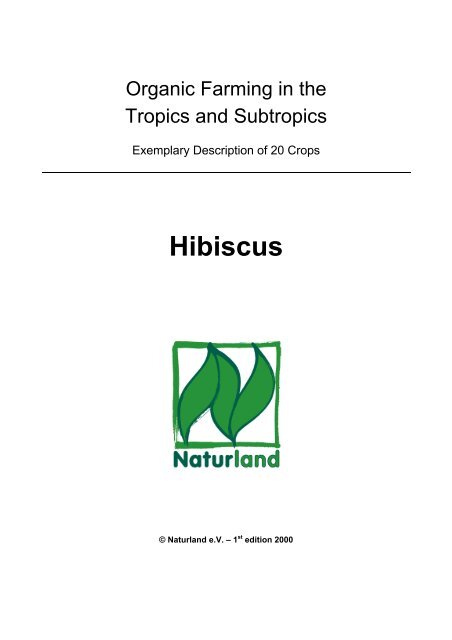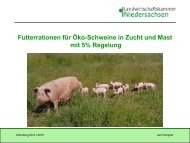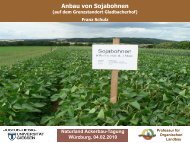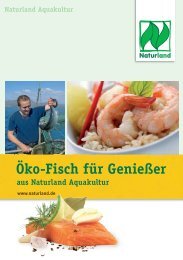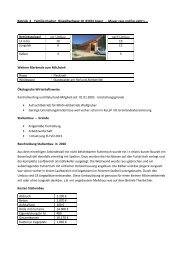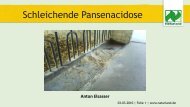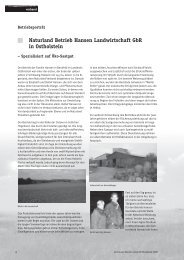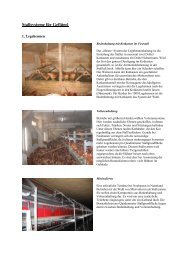Organic Farming in the Tropics and Subtropics: Hibiscus - Naturland
Organic Farming in the Tropics and Subtropics: Hibiscus - Naturland
Organic Farming in the Tropics and Subtropics: Hibiscus - Naturland
Create successful ePaper yourself
Turn your PDF publications into a flip-book with our unique Google optimized e-Paper software.
<strong>Organic</strong> <strong>Farm<strong>in</strong>g</strong> <strong>in</strong> <strong>the</strong><br />
<strong>Tropics</strong> <strong>and</strong> <strong>Subtropics</strong><br />
Exemplary Description of 20 Crops<br />
<strong>Hibiscus</strong><br />
© Naturl<strong>and</strong> e.V. – 1 st edition 2000
These cultivation guidel<strong>in</strong>es have been published by Naturl<strong>and</strong> e.V. with <strong>the</strong> k<strong>in</strong>d support of <strong>the</strong><br />
Deutsche Gesellschaft für Technische Zusammenarbeit mbH (GTZ, German Agency for Technical<br />
Cooperation) f<strong>in</strong>anced by <strong>the</strong> Bundesm<strong>in</strong>isterium für Wirtschaftliche Zusammenarbeit (BMZ,<br />
Federal M<strong>in</strong>istry for Development Cooperation). The cultivation recommendations at h<strong>and</strong> for 20<br />
crops of <strong>the</strong> tropics <strong>and</strong> subtropics be<strong>in</strong>g of significant importance for <strong>the</strong> world economy were<br />
written by various authors.<br />
Naturl<strong>and</strong> would like mention <strong>the</strong> follow<strong>in</strong>g authors <strong>and</strong> thank <strong>the</strong>m for <strong>the</strong>ir contributions:<br />
Franz Augstburger, Jörn Berger, Udo Censkowsky,<br />
Petra Heid, Joachim Milz, Christ<strong>in</strong>e Streit.<br />
The cultivation guidel<strong>in</strong>es are available <strong>in</strong> English, Spanish <strong>and</strong> German for <strong>the</strong> follow<strong>in</strong>g crops:<br />
banana, brazil nut, cashew nut, cocoa, coconut, coffee,<br />
cotton, hibiscus, macadamia, mango, papaya, peanut,<br />
pepper, p<strong>in</strong>eapple, sugar cane, sesame, tea, vanilla.<br />
The cultivation guidel<strong>in</strong>es for Bananas, Mangoes, P<strong>in</strong>eapples <strong>and</strong> Pepper were revised <strong>in</strong> 2001 for<br />
<strong>the</strong> United Nations Conference on Trade <strong>and</strong> Development (UNCTAD) by Udo Censkowsky <strong>and</strong><br />
Friederike Höngen.<br />
In 2002 two more guidel<strong>in</strong>es, for rice <strong>and</strong> date palms, were published <strong>in</strong> English.<br />
All <strong>the</strong> authors emphasize, that <strong>the</strong> cultivation recommendations at h<strong>and</strong> can just provide general<br />
<strong>in</strong>formation. They do not substitute technical assistance to <strong>the</strong> farmers with regard to <strong>the</strong> location.<br />
All <strong>in</strong>dications, data <strong>and</strong> results of this cultivation guidel<strong>in</strong>es have been compiled <strong>and</strong> crosschecked<br />
most carefully by <strong>the</strong> authors. Yet mistakes with regard to <strong>the</strong> contents cannot be<br />
precluded. The <strong>in</strong>dicated legal regulations are based on <strong>the</strong> state of <strong>the</strong> year 1999 <strong>and</strong> are subject<br />
to alterations <strong>in</strong> future. Consequently all <strong>in</strong>formation has to be given <strong>in</strong> exclusion of any obligation<br />
or guarantee by Naturl<strong>and</strong> e.V. or <strong>the</strong> authors. Both Naturl<strong>and</strong> e.V. <strong>and</strong> authors <strong>the</strong>refore do not<br />
accept any responsibility or liability.<br />
Fur<strong>the</strong>rmore <strong>the</strong> authors k<strong>in</strong>dly call upon for critical remarks, additions <strong>and</strong> o<strong>the</strong>r important<br />
<strong>in</strong>formation to be forwarded to <strong>the</strong> address below. The cultivation guidel<strong>in</strong>es will be updated<br />
regularly by Naturl<strong>and</strong> e.V.<br />
Naturl<strong>and</strong> e.V.<br />
Kle<strong>in</strong>haderner Weg 1<br />
82166 Gräfelf<strong>in</strong>g<br />
Germany<br />
phone: +49 - (0)89 - 898082-0<br />
fax: +49 - (0)89 - 898082-90<br />
e-mail: naturl<strong>and</strong>@naturl<strong>and</strong>.de<br />
website: www.naturl<strong>and</strong>.de<br />
We pass our gratitude to Peter Brul of Agro Eco for his helpful comments on <strong>the</strong> manuscript. Our<br />
best thanks are also devoted to all supporters of this publication, <strong>in</strong> particular Mrs Sybille<br />
Groschupf who cleaned up <strong>the</strong> text from errors <strong>in</strong> strenuous detail work <strong>and</strong> did <strong>the</strong> attractive<br />
layout.
II Special section: <strong>Organic</strong> Cultivation of <strong>Hibiscus</strong><br />
Naturl<strong>and</strong> e.V. – 1 st edition 2000<br />
Index<br />
1. Introduction ................................................................................................ 1<br />
1.1. Botany ......................................................................................................... 1<br />
1.2. Varieties <strong>and</strong> countries of orig<strong>in</strong> .............................................................. 1<br />
1.3. Uses <strong>and</strong> contents ..................................................................................... 1<br />
2. Aspects of plant cultivation ...................................................................... 2<br />
2.1. Site requirements....................................................................................... 2<br />
2.2. Seeds .......................................................................................................... 3<br />
2.3. Sow<strong>in</strong>g methods ........................................................................................ 3<br />
2.3.1. Direct sow<strong>in</strong>g................................................................................................ 3<br />
2.3.2. Seed beds .................................................................................................... 3<br />
2.4. Diversification strategies .......................................................................... 4<br />
2.5. Nutrients <strong>and</strong> organic fertilisation management .................................... 5<br />
2.5.1. Nutrients requirements................................................................................. 5<br />
2.6. Biological methods of plant protection ................................................... 5<br />
2.6.1. Diseases ...................................................................................................... 5<br />
2.6.2. Pests ............................................................................................................ 6<br />
2.7. Crop monitor<strong>in</strong>g <strong>and</strong> ma<strong>in</strong>tenance........................................................... 6<br />
2.7.1. Weed management...................................................................................... 6<br />
2.8. Harvest<strong>in</strong>g <strong>and</strong> post harvest treatment ................................................... 6<br />
3. Product specifications............................................................................... 7<br />
3.1. Dried hibiscus blossoms........................................................................... 7<br />
3.1.1. Preparation................................................................................................... 7<br />
3.1.2. Quality requirements .................................................................................... 7<br />
3.1.3. Packag<strong>in</strong>g <strong>and</strong> storage ................................................................................ 9
II Special section: <strong>Organic</strong> <strong>Hibiscus</strong> Cultivation<br />
1. Introduction<br />
1.1. Botany<br />
<strong>Organic</strong> <strong>Hibiscus</strong> Cultivation<br />
(o<strong>the</strong>r names: Florida cranberry, Malva, Roselle)<br />
<strong>Hibiscus</strong> spp. belongs to <strong>the</strong> superorder Malvaceae. They orig<strong>in</strong>ate ei<strong>the</strong>r <strong>in</strong> Angola<br />
<strong>and</strong>/or Sudan, although def<strong>in</strong>itely <strong>in</strong> East Africa. Many different varieties exist,<br />
whereby H. sabdariffa var. sabdariffa are cultivated to be consumed as vegetables<br />
<strong>and</strong> tea, whereas o<strong>the</strong>r hibiscus varieties are planted for <strong>the</strong> fibres <strong>the</strong>y produce.<br />
<strong>Hibiscus</strong> sabdariffa grows <strong>in</strong> bush-form, with branches that po<strong>in</strong>t upwards, <strong>and</strong><br />
smaller twigs; <strong>the</strong> plant is annual or biennial <strong>and</strong> is classed as a pioneer plant.<br />
Depend<strong>in</strong>g on <strong>the</strong> cultivation conditions at <strong>the</strong> site, <strong>and</strong> <strong>the</strong> time of sow<strong>in</strong>g, <strong>the</strong><br />
plants can reach heights between 1 m <strong>and</strong> 3 m. They are generally self-fertilis<strong>in</strong>g,<br />
mean<strong>in</strong>g that own selections (dark colour, little hair) can be created.<br />
1.2. Varieties <strong>and</strong> countries of orig<strong>in</strong><br />
The ma<strong>in</strong> producers of hibiscus blossoms are Egypt, Sudan, Mexico, Thail<strong>and</strong> <strong>and</strong><br />
Ch<strong>in</strong>a. <strong>Organic</strong> hibiscus cultivation is also currently practised <strong>in</strong> Egypt, Tanzania,<br />
Mexico <strong>and</strong> Bolivia.<br />
1.3. Uses <strong>and</strong> contents<br />
Consumable parts <strong>in</strong>clude <strong>the</strong> dried calyxes <strong>and</strong> corollas, which are <strong>the</strong>n harvested.<br />
They are traded as ei<strong>the</strong>r whole or cut dried calyxes, <strong>and</strong> described as hibiscus<br />
blossoms. Ma<strong>in</strong> varieties, along with <strong>Hibiscus</strong> sabdariffa, are H. cannab<strong>in</strong>us (Kenaf)<br />
which is cultivated for its fibres, as well as H. esculentus (okra, ladyf<strong>in</strong>ger) which is<br />
used as a vegetable.<br />
Its acid content of 15-30 % (among o<strong>the</strong>rs citric, malic acid, tartaric acid, hibisc<strong>in</strong>)<br />
lend hibiscus tea (also sold as malvern tea) its pleasantly tart taste. The w<strong>in</strong>e-red<br />
colour is due to an anthocyan<strong>in</strong> content of around 1.5%.<br />
Naturl<strong>and</strong> e.V. – 1 st edition 2000 page 1
II Special section: <strong>Organic</strong> <strong>Hibiscus</strong> Cultivation<br />
calyxes seeds leaves<br />
Prote<strong>in</strong> [g] 2.0 28.9 3.5<br />
carbohydrates [g] 10.2 25.5 8.7<br />
Fat [g] 0.1 21.4 0.3<br />
Vitam<strong>in</strong> A I.E. - - 1000<br />
Thiam<strong>in</strong>e [mg] 0.05 0.1 0.2<br />
Riboflav<strong>in</strong> [mg] 0.07 0.15 0.4<br />
Niac<strong>in</strong> [mg] 0.06 1.5 1.4<br />
Vitam<strong>in</strong> C [mg] 17 - 2.3<br />
Calcium [mg] 150 350 240<br />
iron [mg] 3.0 - 5.0<br />
The fleshy calyxes are eaten raw as fruit, boiled or dried as a tea, whereby <strong>the</strong><br />
foodstuffs take on a deep red colour<strong>in</strong>g. The seeds are ground up to provide a<br />
nutritious foodstuff. Young plants <strong>and</strong> leaves are eaten as leaf vegetables. <strong>Hibiscus</strong><br />
leaves are highly suited as fodder, <strong>and</strong> are favoured by rum<strong>in</strong>ants.<br />
2. Aspects of plant cultivation<br />
2.1. Site requirements<br />
<strong>Hibiscus</strong> prefer warmer climates, <strong>the</strong> optimum temperature be<strong>in</strong>g 25°C, <strong>and</strong> a<br />
ra<strong>in</strong>fall of 400-500 mm spread over <strong>the</strong> 4-5 month vegetation period.<br />
Due to its critical photoperiod of around 12 hours, cultivation of hibiscus is limited to<br />
<strong>the</strong> regions below 25° geographical longitude. Reproduction requires a dark period<br />
of at least 11.5 hours, flower formation is dur<strong>in</strong>g <strong>the</strong> daytime lengths of 12.5-13.5<br />
hours, dur<strong>in</strong>g which, upwards growth is also term<strong>in</strong>ated.<br />
The follow<strong>in</strong>g table provides data concern<strong>in</strong>g <strong>the</strong> plant’s development <strong>in</strong> relationship<br />
to hours of daylight (average values). 1<br />
Treatment (daylight<br />
hours)<br />
Height when<br />
blossom<strong>in</strong>g<br />
began (<strong>in</strong> cm)<br />
Stem circumference<br />
when blossom<strong>in</strong>g<br />
began (<strong>in</strong> cm)<br />
Days until<br />
blossom<strong>in</strong>g<br />
began<br />
8 93,8 2,984 87,5 92<br />
10 71,36 2,125 69,25 75<br />
12 210,7 4,1 126 131<br />
14 240,78 4,6 141 150<br />
16 235,0 5,28 154 162<br />
Control* 236,7 5,0 122 127<br />
Days until fructification<br />
(creation of first visible fruit<br />
cusps)<br />
*Daylight lengths of 13 hours 20 m<strong>in</strong>s. cont<strong>in</strong>ually ris<strong>in</strong>g until blossom<strong>in</strong>g began to 13 hours 31 m<strong>in</strong>s.<br />
<strong>and</strong> reduction once blossom<strong>in</strong>g had commenced to 12 hours 5 m<strong>in</strong>s.<br />
1 Nature, Vol 170 (Sept 1953)<br />
Naturl<strong>and</strong> e.V. – 1 st edition 2000 page 2
II Special section: <strong>Organic</strong> <strong>Hibiscus</strong> Cultivation<br />
The table clearly shows that an <strong>in</strong>crease <strong>in</strong> <strong>the</strong> hours of daylight ma<strong>in</strong>ly encourages<br />
vegetative growth, whilst simultaneously, <strong>the</strong> time until fructification is significantly<br />
delayed.<br />
The appropriate sow<strong>in</strong>g time needs to be evaluated accord<strong>in</strong>g to site conditions. If<br />
sow<strong>in</strong>g is carried out very early, that is, at a time when <strong>the</strong> daylight hours are rapidly<br />
leng<strong>the</strong>n<strong>in</strong>g, <strong>the</strong>n strong vegetative growth will occur, <strong>the</strong> vegetation period will<br />
extend, <strong>and</strong> <strong>the</strong> calyxes will later be very light <strong>in</strong> weight. If sow<strong>in</strong>g is performed at a<br />
later date, <strong>the</strong> plant’s vegetative development is lessened, <strong>and</strong> it will beg<strong>in</strong> to<br />
blossom at a shorter height.<br />
<strong>Hibiscus</strong> sabdariffa prefers heavy soils. Stagnant water must be avoided.<br />
In Africa, hibiscus is sown as an annual crop. Yet experiences <strong>in</strong> Bolivia that<br />
biennial cultivation is possible, if <strong>the</strong> foliage is cut back.<br />
2.2. Seeds<br />
In market terms, <strong>the</strong> most important parts of <strong>the</strong> plant are <strong>the</strong> deep red dried<br />
calyxes, so that dr<strong>in</strong>ks made from <strong>the</strong>se will take on a characteristic colour<strong>in</strong>g. This<br />
characteristic should <strong>the</strong>refore be noted dur<strong>in</strong>g sort<strong>in</strong>g. Some varieties are very<br />
hairy, which is a h<strong>in</strong>drance dur<strong>in</strong>g <strong>the</strong> harvest – this should <strong>the</strong>refore be considered<br />
when choos<strong>in</strong>g seeds. It is recommended to select your own seeds on site (less<br />
hairs, deep red colour, acid content).<br />
The weight per thous<strong>and</strong> seeds is around 29 g, die ability of germ<strong>in</strong>ation after one<br />
year is still over 90 %. Depend<strong>in</strong>g on <strong>the</strong> seed density, <strong>the</strong> amount of seeds needed<br />
for 1 hectare is around 2000 g. The seeds do not require any pre-treatment.<br />
2.3. Sow<strong>in</strong>g methods<br />
2.3.1. Direct sow<strong>in</strong>g<br />
<strong>Hibiscus</strong> can be directly sown without any problem, whereby 3-5 seeds are sown<br />
per hole. Germ<strong>in</strong>ation beg<strong>in</strong>s after 2-3 days. The distances between plants depends<br />
largely on <strong>the</strong>ir amount of growth, which <strong>in</strong> turn depends upon <strong>the</strong> variety, <strong>the</strong> time<br />
of sow<strong>in</strong>g, <strong>the</strong> soil <strong>and</strong> <strong>the</strong> climatic conditions. If <strong>the</strong>re is sufficient ra<strong>in</strong>fall, <strong>and</strong> <strong>the</strong><br />
soil fertility is high enough, <strong>the</strong>n 1 x 1 m is appropriate. Sow<strong>in</strong>g closer toge<strong>the</strong>r can<br />
lead to overshadow<strong>in</strong>g as well as fungi <strong>in</strong>festation of <strong>the</strong> plants <strong>and</strong> calyxes. Yet<br />
dur<strong>in</strong>g <strong>the</strong> first stages of development, it might make sense to sow closer toge<strong>the</strong>r,<br />
so that <strong>the</strong> soil is protected by <strong>the</strong> plant cover<strong>in</strong>g (<strong>and</strong> <strong>the</strong>refore weeds suppressed).<br />
It will <strong>the</strong>n be necessary, though, to th<strong>in</strong> out <strong>the</strong> crop.<br />
2.3.2. Seed beds<br />
Pre-plant<strong>in</strong>g <strong>the</strong> seeds <strong>in</strong> seed beds is possible, <strong>and</strong> especially recommended if few<br />
seeds are available. This propagation technique is recommended if <strong>the</strong> hibiscus is<br />
Naturl<strong>and</strong> e.V. – 1 st edition 2000 page 3
II Special section: <strong>Organic</strong> <strong>Hibiscus</strong> Cultivation<br />
to be comb<strong>in</strong>ed with o<strong>the</strong>r crops, that have already emerged, or which generally<br />
develop quicker than <strong>the</strong> hibiscus. <strong>Hibiscus</strong> plants are relatively unaffected by<br />
transplant<strong>in</strong>g <strong>and</strong> can even withst<strong>and</strong> short drought periods. The transplantations<br />
should be carried out before <strong>the</strong> plants are more than 20 cm tall, o<strong>the</strong>rwise yields<br />
may drop – even if <strong>the</strong> plants survive. Proliferation via cutt<strong>in</strong>gs is also possible.<br />
2.4. Diversification strategies<br />
<strong>Hibiscus</strong> is a pioneer crop that cannot tolerate shade, which should be taken <strong>in</strong>to<br />
account when plann<strong>in</strong>g <strong>the</strong> plantation.<br />
Depend<strong>in</strong>g on <strong>the</strong> soil conditions, distances between <strong>the</strong> plants as well as<br />
availability of water, a plantation can be fully grown after only 2-3 months. Yet<br />
because <strong>the</strong> vegetation period is concluded after 4 up to max. 5 months, o<strong>the</strong>r crops<br />
which have longer vegetation periods can easily be comb<strong>in</strong>ed with hibiscus plants.<br />
After <strong>the</strong> calyxes have been picked, <strong>the</strong> hibiscus plants are cut down <strong>and</strong> rema<strong>in</strong> out<br />
on <strong>the</strong> field. Due to <strong>the</strong> relatively high percentage of bio-mass produced, hibiscus is<br />
an excellent crop for enrich<strong>in</strong>g <strong>the</strong> soil with organic material.<br />
On marg<strong>in</strong>al, dry sites, hibiscus builds a very dense blanket of foliage, <strong>and</strong> <strong>the</strong>refore<br />
provides <strong>the</strong> soil with plenty of protection.<br />
Cultivation <strong>in</strong> agroforestry systems: <strong>Hibiscus</strong> can be cultivated toge<strong>the</strong>r with<br />
coffee, cocoa, bananas, lemons, p<strong>in</strong>eapples <strong>and</strong> o<strong>the</strong>r varieties of fruit, yet because<br />
hibiscus cannot tolerate shade, <strong>the</strong>y should to be planted <strong>in</strong> agro forestry systems<br />
when <strong>the</strong> o<strong>the</strong>r crops have been substantially cut back. After well-established coffee<br />
plantations have been regenerated, with a simultaneous cutt<strong>in</strong>g back of <strong>the</strong> foliage,<br />
hibiscus can be utilised to fill <strong>in</strong> <strong>the</strong> gap before <strong>the</strong> next coffee harvest.<br />
Cultivation <strong>in</strong> field crop rotation: Traditionally, hibiscus is generally sown on<br />
poorer soils, each year on a different plot. The crop mostly follows a fallow stage, or<br />
crops such as rice, maize, sorgo, beans or peanuts. In <strong>the</strong>se cases, sufficient green<br />
fertiliser must be provided, as well as <strong>the</strong> <strong>in</strong>tegration of legum<strong>in</strong>a crops with<strong>in</strong> <strong>the</strong><br />
crop rotation. <strong>Hibiscus</strong> is not suited to be<strong>in</strong>g planted aga<strong>in</strong> on <strong>the</strong> same plot, as this<br />
can lead to rapid nematode <strong>in</strong>festation (comp. 2.6.). Simultaneous cultivation of<br />
cotton <strong>and</strong> <strong>Hibiscus</strong> <strong>in</strong> a s<strong>in</strong>gle crop rotation should be avoided (both are Malvern<br />
crops).<br />
Examples of crop rotation with hibiscus:<br />
Tanzania <strong>Hibiscus</strong> - <strong>Hibiscus</strong> – green fallow (with Crotolaria ochrolenca)<br />
Egypt <strong>Hibiscus</strong> - sesame - clover - herbs<br />
Mexico <strong>Hibiscus</strong> - maize - fallow - fallow<br />
Naturl<strong>and</strong> e.V. – 1 st edition 2000 page 4
II Special section: <strong>Organic</strong> <strong>Hibiscus</strong> Cultivation<br />
2.5. Nutrients <strong>and</strong> organic fertilisation management<br />
2.5.1. Nutrients requirements<br />
Literary sources of fertiliser recommendations are based on hibiscus cultivated for<br />
<strong>the</strong>ir fibres. These are high due to <strong>the</strong> high levels of bio-mass produced, that is <strong>the</strong>n<br />
also removed from <strong>the</strong> system.<br />
In <strong>the</strong> case of organic hibiscus cultivation to produce dried calyxes, practically all of<br />
<strong>the</strong> organic material rema<strong>in</strong>s with<strong>in</strong> <strong>the</strong> system, <strong>the</strong>reby enrich<strong>in</strong>g it with bio-mass.<br />
Because <strong>in</strong> <strong>the</strong> case of hibiscus cultivation, an enrichment of <strong>the</strong> soil fertility should<br />
also occur with<strong>in</strong> <strong>the</strong> entire system, special fertiliser recommendations are not<br />
necessary for <strong>the</strong> crop. If <strong>the</strong>y are not <strong>in</strong>tended to be planted as a pioneer crop to<br />
start off an agro forestry system, care should be taken to ensure that sufficient<br />
legumes are <strong>in</strong>tegrated with<strong>in</strong> <strong>the</strong> crop rotation.<br />
2.6. Biological methods of plant protection<br />
2.6.1. Diseases<br />
The most important diseases are types of stale rot of rape, more seldomly<br />
anthracnose, caused by different fungi varieties.<br />
The most important fungus parasites of <strong>the</strong> stems, leaves <strong>and</strong> roots:<br />
Fungi Disease <strong>in</strong>dications<br />
Phytophtora parasitica<br />
Phoma sabdariffae<br />
Macrophom<strong>in</strong>a phaesol<strong>in</strong>a<br />
Rhizoctonia solani<br />
Botrytis c<strong>in</strong>erea<br />
Sclerotium rolfsii<br />
Root rot <strong>and</strong> stale rot of rape<br />
Leaf fleck<br />
Blackleg, stalk base rot <strong>and</strong> root rot, Shank<strong>in</strong>g<br />
root rot, seed rot,<br />
root rot<br />
Seed <strong>and</strong> stem rot<br />
Most types of stem or root rot occur dur<strong>in</strong>g very long periods of heavy ra<strong>in</strong>, or <strong>in</strong><br />
cases of stagnant water. Too short <strong>in</strong>tervals of hibiscus cultivation <strong>in</strong> <strong>the</strong> crop<br />
rotation or depleted soils can also be <strong>the</strong> cause. Direct methods of controll<strong>in</strong>g soilborne<br />
diseases do not exist. Chang<strong>in</strong>g <strong>the</strong> site, or better care of <strong>the</strong> soil are two<br />
ways of alleviat<strong>in</strong>g <strong>the</strong> problem.<br />
If heavy ra<strong>in</strong>fall occurs dur<strong>in</strong>g <strong>the</strong> blossom<strong>in</strong>g time, <strong>the</strong>n it is possible that <strong>the</strong> petals<br />
rema<strong>in</strong> attached to <strong>the</strong> calyxes, <strong>in</strong>stead of fall<strong>in</strong>g to <strong>the</strong> ground. These rema<strong>in</strong><br />
attached, <strong>and</strong> rot on <strong>the</strong> plant, which can also affect <strong>the</strong> calyxes. For this reason,<br />
petals that rema<strong>in</strong> on <strong>the</strong> plants should be removed.<br />
The plants can easily fall over when laden with a lot of heavy fruit, result<strong>in</strong>g <strong>in</strong> many<br />
of <strong>the</strong> calyxes rott<strong>in</strong>g on or near <strong>the</strong> ground. This can be avoided by support<strong>in</strong>g <strong>the</strong><br />
plants with sticks.<br />
Naturl<strong>and</strong> e.V. – 1 st edition 2000 page 5
II Special section: <strong>Organic</strong> <strong>Hibiscus</strong> Cultivation<br />
2.6.2. Pests<br />
<strong>Hibiscus</strong> is extremely susceptible to nematode <strong>in</strong>fection. O<strong>the</strong>r damag<strong>in</strong>g organism<br />
do not generally play an important role. Direct measures to reduce <strong>the</strong> number of<br />
nematodes <strong>in</strong> <strong>the</strong> soil are not usually very successful, which means that an<br />
<strong>in</strong>festation must be avoided as well as possible by use of a suitable crop rotation<br />
system. Studies <strong>in</strong> Tanzania have shown that beetles that w<strong>and</strong>er onto <strong>the</strong> hibiscus<br />
plot can cause significant damage. The hibiscus crops can be protected aga<strong>in</strong>st this<br />
by plant<strong>in</strong>g an additional strip of Okra (<strong>Hibiscus</strong> esculentus) around <strong>the</strong> field.<br />
2.7. Crop monitor<strong>in</strong>g <strong>and</strong> ma<strong>in</strong>tenance<br />
2.7.1. Weed management<br />
Measures used to regulate <strong>the</strong> growth of weeds are largely dependent on <strong>the</strong> site<br />
conditions, as well as <strong>the</strong> type of cultivation system. The plants develop slowly at<br />
<strong>the</strong> beg<strong>in</strong>n<strong>in</strong>g. If <strong>the</strong> crop is sown directly from seeds, <strong>the</strong>n till<strong>in</strong>g of tall-grow<strong>in</strong>g<br />
weeds <strong>and</strong> grasses may be required once or twice, yet as soon as <strong>the</strong> crop is fully<br />
grown, no fur<strong>the</strong>r weed<strong>in</strong>g is necessary.<br />
2.8. Harvest<strong>in</strong>g <strong>and</strong> post harvest treatment<br />
Harvest<strong>in</strong>g commences once <strong>the</strong> calyxes have reached an optimum size. This po<strong>in</strong>t<br />
is generally reached shortly before <strong>the</strong> seed capsules are ready to open, 15-20 days<br />
after blossom<strong>in</strong>g. The fruit is separated with <strong>the</strong> calyx petals manually, ei<strong>the</strong>r by<br />
h<strong>and</strong>, or with a knife. Afterwards, <strong>the</strong> seed capsules need to be carefully removed<br />
from <strong>the</strong> calyxes. Round, sharpened metal tubes can be used for this, to cut away<br />
<strong>the</strong> seed capsules at <strong>the</strong> base, <strong>and</strong> remove <strong>the</strong>m.<br />
F<strong>in</strong>ally, <strong>the</strong> water-logged calyx petals are dried out <strong>in</strong> <strong>the</strong> sun, which should be<br />
performed as quickly as possible. The dry<strong>in</strong>g process must be concluded as rapidly<br />
as possible, o<strong>the</strong>rwise, <strong>the</strong>re is risk of an <strong>in</strong>fection of mould fungi. Suitable dry<strong>in</strong>g<br />
areas <strong>and</strong> methods (e.g. solar dryers) should especially be made available <strong>in</strong><br />
regions where it can ra<strong>in</strong> dur<strong>in</strong>g <strong>the</strong> harvest.<br />
The harvest must be stored <strong>in</strong> a dry place, protected from light <strong>and</strong> well-ventilated.<br />
Measures to protect aga<strong>in</strong>st storage pests should be adopted when stor<strong>in</strong>g hibiscus.<br />
In Tanzania, neem leaves are strewn among <strong>the</strong> hibiscus.<br />
Naturl<strong>and</strong> e.V. – 1 st edition 2000 page 6
II Special section: <strong>Organic</strong> <strong>Hibiscus</strong> Cultivation<br />
3. Product specifications<br />
Accord<strong>in</strong>g to <strong>the</strong> DAB (German Journal of Medicaments) 1996, a m<strong>in</strong>imum of<br />
13.5% acid content (calculated as citric acid), as well as a specific colour<strong>in</strong>g (at least<br />
0.350 measured as an absorption at 520 nm, us<strong>in</strong>g water as a compensation fluid)<br />
are required. The total water content of <strong>the</strong> fresh fruit, <strong>in</strong>clud<strong>in</strong>g <strong>the</strong> calyx petals,<br />
should be around 84.5%.<br />
3.1. Dried hibiscus blossoms<br />
3.1.1. Preparation<br />
The fleshy, bright red calyxes of <strong>the</strong> <strong>Hibiscus</strong> sabdariffa L. can be eaten fresh as<br />
fruit, or be processed <strong>in</strong>to refresh<strong>in</strong>g dr<strong>in</strong>ks, teas <strong>and</strong> jellies.<br />
Ma<strong>in</strong> exports are <strong>the</strong> dried hibiscus blossoms known as “<strong>Hibiscus</strong> tea” (whole or cut<br />
up). They are usually sold as herbal teas, or mixed toge<strong>the</strong>r with rose hip or fruits,<br />
<strong>and</strong> sold as fruit teas <strong>in</strong> tea bags or as loose leaves.<br />
The follow<strong>in</strong>g describes how hibiscus blossoms are processed:<br />
Dry<strong>in</strong>g<br />
In order to process dried hibiscus blossoms, <strong>the</strong> calyx <strong>and</strong> petals of <strong>Hibiscus</strong><br />
sabdariffa L are harvested at <strong>the</strong> correct time <strong>and</strong> dried to a maximum water content<br />
of 12%. Dur<strong>in</strong>g <strong>the</strong> dry<strong>in</strong>g process, it is important to extract <strong>the</strong> water as carefully as<br />
possible. The most important factors are a temperature that is not too high, <strong>and</strong><br />
sufficient ventilation. The calyxes can be laid out <strong>in</strong> th<strong>in</strong> layers on racks, <strong>and</strong> dried<br />
by <strong>the</strong> sun <strong>and</strong> w<strong>in</strong>d.<br />
Sort<strong>in</strong>g <strong>and</strong> packag<strong>in</strong>g<br />
After <strong>the</strong> dry<strong>in</strong>g process, <strong>the</strong> dried hibiscus blossoms are sifted through for stem <strong>and</strong><br />
o<strong>the</strong>r foreign particles, <strong>and</strong> packaged ei<strong>the</strong>r whole or cut up.<br />
Dur<strong>in</strong>g <strong>the</strong> dry<strong>in</strong>g process, <strong>the</strong> hibiscus blossoms are not allowed to be treated with<br />
ei<strong>the</strong>r methyl bromide or ethylene oxide, or with ionisation rays.<br />
3.1.2. Quality requirements<br />
These quality requirements for dried hibiscus blossoms, with <strong>the</strong>ir m<strong>in</strong>imum <strong>and</strong><br />
maximum values, are generally issued by <strong>the</strong> authorities or importers. Yet<br />
agreements may be reached between <strong>in</strong>dividual manufacturers <strong>and</strong> importers upon<br />
different values, provid<strong>in</strong>g <strong>the</strong>y still conform to official requirements.<br />
Naturl<strong>and</strong> e.V. – 1 st edition 2000 page 7
II Special section: <strong>Organic</strong> <strong>Hibiscus</strong> Cultivation<br />
Quality requirements M<strong>in</strong>imum <strong>and</strong> maximum values<br />
Taste <strong>and</strong> smell Variety-specific, aromatic, not stale, tart (<strong>in</strong>fusion)<br />
Cleanl<strong>in</strong>ess<br />
Dry weight m<strong>in</strong>. 90.0 %<br />
Water content max. 12.0 %<br />
Total ash max. 11.0 %<br />
Hydrochloric acid soluble ash max. 2.5 %<br />
Residues<br />
Pesticide Not measurable<br />
Bromide <strong>and</strong> ethylene oxide Not measurable<br />
Micro-organisms<br />
Aerobe Bacteria max. 10,000,000/g<br />
Yeasts <strong>and</strong> mould fungi max. 10,000/g<br />
Escherichia coli max. 100/g<br />
Enterobacteriaceae max. 10,000/g<br />
Salmonella Not measurable <strong>in</strong> 20 g<br />
Mycotox<strong>in</strong>s<br />
Aflatox<strong>in</strong> B1 max. 2 µg/kg<br />
Total aflatox<strong>in</strong>s B1, B2, G1, G2 max. 4 µg/kg<br />
Free of foreign substances such as s<strong>and</strong>, stones,<br />
stems, <strong>in</strong>sects etc<br />
The ‘DAB’ from 1996 also dem<strong>and</strong>s a m<strong>in</strong>imum of 13.5% acid content (calculated as<br />
citric acid), when <strong>the</strong> dried hibiscus blossoms are to be used medic<strong>in</strong>ally, e.g. to be<br />
sold <strong>in</strong> chemists.<br />
In order to conform to <strong>the</strong> quality requirements, <strong>and</strong> to prevent <strong>the</strong> dried hibiscus<br />
blossoms becom<strong>in</strong>g contam<strong>in</strong>ated, all preparations must be carried out under clean,<br />
hygienic <strong>and</strong> acceptable conditions. The follow<strong>in</strong>g aspects must be heeded:<br />
Equipment (tubs, knives etc.), as well as work<strong>in</strong>g surfaces (tables etc.) <strong>and</strong><br />
prepar<strong>in</strong>g <strong>and</strong> storage rooms, should be cleaned regularly.<br />
Personnel should be healthy, <strong>and</strong> have <strong>the</strong> possibility to wash <strong>the</strong>mselves, or at<br />
least <strong>the</strong>ir h<strong>and</strong>s (washrooms, toilets) <strong>and</strong> wear clean, washable overgarments.<br />
Water used for cleans<strong>in</strong>g purposes must be free from faeces <strong>and</strong> o<strong>the</strong>r<br />
contam<strong>in</strong>ants.<br />
Animals or animal faeces must not come <strong>in</strong>to contact with <strong>the</strong> processed dried<br />
hibiscus blossoms.<br />
Naturl<strong>and</strong> e.V. – 1 st edition 2000 page 8
II Special section: <strong>Organic</strong> <strong>Hibiscus</strong> Cultivation<br />
3.1.3. Packag<strong>in</strong>g <strong>and</strong> storage<br />
Packag<strong>in</strong>g types <strong>and</strong> material<br />
In order to be exported to Europe, <strong>the</strong> dried hibiscus blossoms can be packed <strong>in</strong><br />
consumer packs, or wholesaler packs (bulk) <strong>in</strong> bags made of sealable, foils,<br />
impermeable to steam (e.g. polyethylene or polypropylene). Before seal<strong>in</strong>g, a gas<br />
(e.g. nitrogen) may be added (nitrogen flush<strong>in</strong>g).<br />
Consumer packages<br />
If <strong>the</strong> dried hibiscus blossoms are not to be packaged <strong>in</strong> bulk conta<strong>in</strong>ers <strong>in</strong> <strong>the</strong><br />
country of orig<strong>in</strong>, but sealed <strong>in</strong> consumer packages, <strong>the</strong>n this packag<strong>in</strong>g should fulfil<br />
<strong>the</strong> follow<strong>in</strong>g functions:<br />
• Protect <strong>the</strong> hibiscus tea from loss of aroma <strong>and</strong> aga<strong>in</strong>st undesirable smells <strong>and</strong><br />
tastes from its surround<strong>in</strong>gs (aroma protection).<br />
• Offer sufficient conservation properties, especially aga<strong>in</strong>st loss or ga<strong>in</strong> of<br />
moisture.<br />
• Protect <strong>the</strong> contents aga<strong>in</strong>st damag<strong>in</strong>g.<br />
• Provide a surface area for advertis<strong>in</strong>g <strong>and</strong> product <strong>in</strong>formation.<br />
• Provide an easy to open access, that can also be sealed aga<strong>in</strong>, so that hibiscus<br />
tea rema<strong>in</strong><strong>in</strong>g <strong>in</strong> <strong>the</strong> packag<strong>in</strong>g stays fresh.<br />
The follow<strong>in</strong>g materials can be used as product packag<strong>in</strong>g:<br />
• Cardboard boxes with or without a transparent cellophane w<strong>in</strong>dow, polyethylene<br />
or polypropylene, or with an <strong>in</strong>ternal bag made of polyethylene or polypropylene<br />
• S<strong>in</strong>gle-layer plastic bags (polyethylene or polypropylene)<br />
If <strong>the</strong> hibiscus tea is not be sold loosely, but <strong>in</strong> tea bags, <strong>the</strong>n <strong>the</strong> bags should be<br />
made of non-glued s<strong>in</strong>gle or double chamber bags with a str<strong>in</strong>g <strong>and</strong> label attached.<br />
The bags are generally sold additionally packed <strong>in</strong> 20 bag cartons, with a<br />
cellophane wrapp<strong>in</strong>g.<br />
Transport packag<strong>in</strong>g<br />
Some form of transport packag<strong>in</strong>g is required <strong>in</strong> order to ship <strong>the</strong> bulk or s<strong>in</strong>gly<br />
packed dried hibiscus blossoms. In choos<strong>in</strong>g a type of packag<strong>in</strong>g, <strong>the</strong> follow<strong>in</strong>g<br />
should be heeded:<br />
Transport packag<strong>in</strong>g made, for example, out of cardboard, should be strong enough<br />
to protect <strong>the</strong> contents aga<strong>in</strong>st be<strong>in</strong>g damaged by outside pressure.<br />
The packag<strong>in</strong>g should be dimensioned to allow <strong>the</strong> contents to be held firmly, but<br />
not too tightly <strong>in</strong> place.<br />
The dimensions should be compatible with st<strong>and</strong>ard pallet <strong>and</strong> conta<strong>in</strong>er<br />
dimensions.<br />
Naturl<strong>and</strong> e.V. – 1 st edition 2000 page 9
II Special section: <strong>Organic</strong> <strong>Hibiscus</strong> Cultivation<br />
Information pr<strong>in</strong>ted on transport packag<strong>in</strong>g<br />
The transport packag<strong>in</strong>g should display details of <strong>the</strong> follow<strong>in</strong>g:<br />
• Name <strong>and</strong> address of <strong>the</strong> manufacturer/packer <strong>and</strong> country of orig<strong>in</strong><br />
• Description of <strong>the</strong> product <strong>and</strong> its quality class<br />
• Year harvested<br />
• Net weight, number<br />
• Batch number<br />
• Dest<strong>in</strong>ation, with <strong>the</strong> trader’s/importer’s address<br />
2 3<br />
• Visible <strong>in</strong>dication of <strong>the</strong> organic orig<strong>in</strong> of <strong>the</strong> product<br />
Storage<br />
The dried hibiscus blossoms should be stored <strong>in</strong> dark areas at low temperatures<br />
(maximum 15-20°C) <strong>and</strong> relative humidity (max. 60 %). Under optimum conditions,<br />
dried hibiscus blossoms can be stored for around 12-18 months.<br />
If <strong>the</strong> organic product is be<strong>in</strong>g stored <strong>in</strong> a s<strong>in</strong>gle warehouse toge<strong>the</strong>r with<br />
conventional hibiscus mix<strong>in</strong>g of <strong>the</strong> different qualities must be avoided. This is best<br />
achieved us<strong>in</strong>g <strong>the</strong> follow<strong>in</strong>g methods:<br />
Tra<strong>in</strong><strong>in</strong>g <strong>and</strong> <strong>in</strong>form<strong>in</strong>g of warehouse personnel<br />
Explicit signs <strong>in</strong> <strong>the</strong> warehouse (silos, pallets, tanks etc.)<br />
Colour differentiation (e.g. green for <strong>the</strong> organic product)<br />
Incom<strong>in</strong>g/dispatched goods separately documented (warehouse logbook)<br />
It is prohibited to carry out chemical storage measures (e.g. gass<strong>in</strong>g with methyl<br />
bromide) <strong>in</strong> mixed storage spaces. Wherever possible, stor<strong>in</strong>g both organic <strong>and</strong><br />
conventional products toge<strong>the</strong>r <strong>in</strong> <strong>the</strong> same warehouse should be avoided.<br />
2 When products from organic farms are be<strong>in</strong>g declared as such, it is necessary to adhere to <strong>the</strong><br />
requisite government regulations of <strong>the</strong> import<strong>in</strong>g country. Information concern<strong>in</strong>g this is available from<br />
<strong>the</strong> appropriate certification body. The regulation (EEC) 2092/91 is applicable to organic products be<strong>in</strong>g<br />
imported <strong>in</strong>to Europe.<br />
3 <strong>Organic</strong> products must be protected from contam<strong>in</strong>ation by non-compliant substances at each stage<br />
<strong>in</strong> <strong>the</strong> process, i.e. process<strong>in</strong>g, packag<strong>in</strong>g, shipp<strong>in</strong>g. Therefore, products orig<strong>in</strong>at<strong>in</strong>g from a certified<br />
organic farm must be recognisably declared as such.<br />
Naturl<strong>and</strong> e.V. – 1 st edition 2000 page 10


